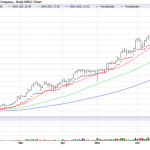Exemplary business owners or CEO’s are a rare breed, but they do exist and Fundstrat recently set out to find them.
Indeed, researchers at Fundstrat Global Advisors released a research report this week outlining their “Captain Ahab Strategy,” which was designed to identify “whale” CEOs and locate compelling investment ideas.
Five CEOs immediately stood out to Fundstrat’s researchers: John Malone, Randal Kirk, Ed Breen, Elon Musk, and Scott L. Thompson. These five have all shown exceptional returns both on a cumulative basis and on a weighted average compound annual growth rate basis.
Of these five, John Malone is the clear outlier. Over a span of 40 years, Malone has achieved a weighted average CAGR of approximately 23% compared to 11% for the S&P 500 through the appropriate use of leverage, buybacks, and artful corporate structuring.
Investors underestimate the importance of a key CEO
Earlier in the week, I covered a survey of Berkshire Hathaway’s operating managers from the Stanford School of Business’ Corporate Governance Research Initiative. The survey questioned approximately 80 managers of Berkshire subsidiaries. The managers had an average tenure of 12 years, and because they’d been in the position for so long, always planned for the long-term, which ultimately improved business performance.
Fundstrat’s research points out that since 2004, an average of 53 CEO’s, or 11%, are new to S&P 500 companies each year. As a result, investors have, on average, 50 opportunities every year to identify potential inflection points in a corporation’s fate based on management change.
Between 2004 and 2014 there have been 580 CEO departures from S&P 500 companies. Assuming that each new CEO brings several changes to the business he/she is taking over, it’s easy to see why so many businesses struggle to execute a clear, consistent long-term strategy.














Leave A Comment